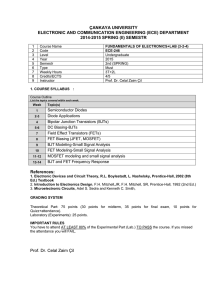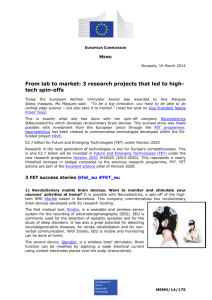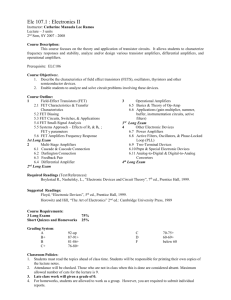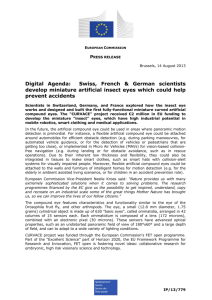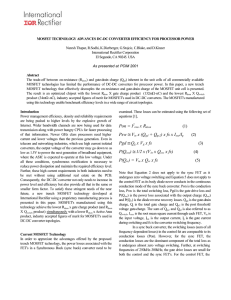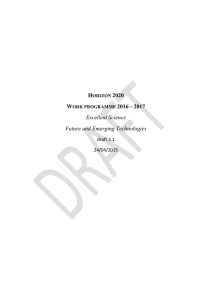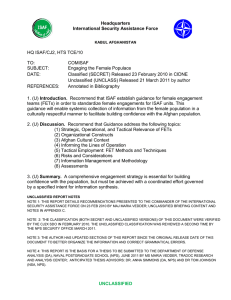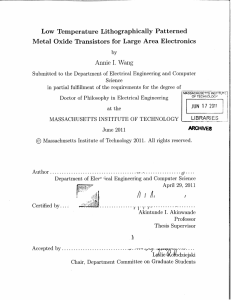ResearchPresentations\Power FET Structures and Applications
advertisement
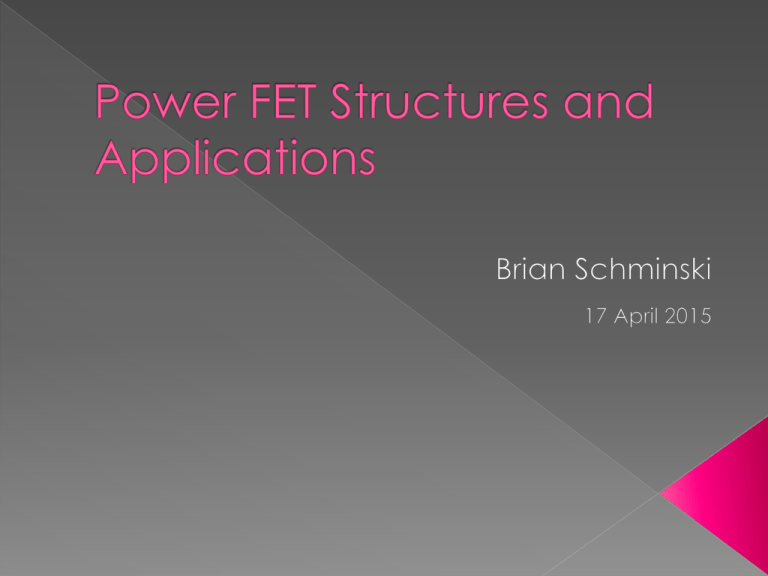
Power FETs are an integral power device, it’s ability to switch from on-state to off-state is crucial in quick switching devices. All the while also having the ability to deal with large current and voltages. Although the Power FET can be tricky when dealing with temperature, has some manufacturing produced devices, but overall it is a necessary to use these FETs. Power FET why is it different? Structures FET subtleties Specific FET example Applications Why use it? Symbol Fabrication Vs Normal FET Vs other power devices Ability to deal with very high voltages High commutation Speed Ability to deal with high sustained currents Good Efficiency at Low Voltages Normal FET Power FET A generic Power FET symbol Power FET with Parasitic capacitances • Trench Etching • Typical etching uses SF6/O2 plasma • Reactive Ion Beam Etching(RIE) • Since Trench depth is so important, another important technique is Interferometric End Point Detection(IEPD) • Self Aligned Fabrication • Trench filling for use of Selective etching VMOS UMOS The V-groove is fabricated by anisotropically etching a (100) silicon surface using a concentrated KOH solution Notice the current vs temp effect on Rds… Paralleling these devices ensures thermal stability, but this in turn throws off current flow due to a uneven amount of current sharing Switching speed › Non affected Threshold voltage › Goes down as temp goes up Transfer Characteristics › The transfer characteristics are dependent on drain current and temperature › The tipping point occurs at 100 amps At this point the temp coefficient goes from negative to positive The act of being removed from powering the gate but the FET still operating. Naturally there is a J-FET formed in layering the material It is expected and planned for This FET has a major influence on Rds The diode is intrinsically formed and cause the reverse drain current to be unblock able. It forms a short for high amounts of current to flow. Layering the MOSFET structure forms the parasitic BJT The base of the BJT is shorted to prevent latch up (short circuit) This latch up is theoretically possible if a very high dV/dt occurs The amount of charge that is required during the MOSFETS turn-on and turn-off transition Pd is based on junction to case thermal resistance to achieve this 25 C is needed Pdsm is based on junction to ambient thermal resistance max temp is 150 C 100V, N-Channel NexFET Power MOSFET › A Texas Instruments device Component specific curves Switching Motor Control Simple Motor Control Motor Control 2 Complimentary Motor Control Power FET can handle more current and more voltage and current The two types of FETs UMOS and VMOS Can be Temperature dependent The Effect of layering the material created certain desired and undesired elements We looked at a specific Power FET We saw some uses of the Power FET http://www.aosmd.com/res/application_notes/mosfets/P ower_MOSFET_Basics.pdf https://www.fairchildsemi.com/application-notes/AN/AN558.pdf http://www.ixys.com/Documents/AppNotes/IXAN0061.pdf Dpdge, Jonathan. “Power MOSFET Tutorial.” 10 Mar. 2015. PDF file http://web.iitd.ac.in/~mamidala/HTMLobj-1474/TrenchMOSFET-Book-Chapter-27-Aug-12.pdf http://www.ti.com/product/CSD19536KCS/datasheet http://www.learningaboutelectronics.com/Articles/NChannel-JFET-characteristics-curve http://www.electronics-tutorials.ws/transistor/tran_7.html http://ecee.colorado.edu/~bart/book/book/chapter7/ch 7_8.htm Two types of FETS : UMOS and VMOS 2. The channel etching occurs along certain lattice planes 3. For use with High currents and Higher Voltages 4. Temperature affects Threshold Voltage, Resistance and Transfer Characteristics 5. Latch up, advantage and disadvantage 1.

